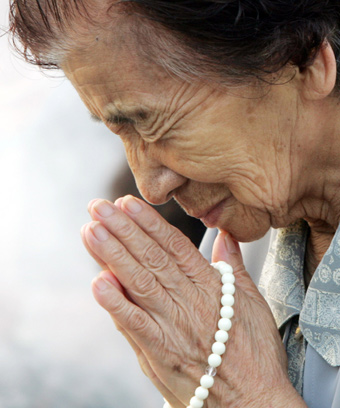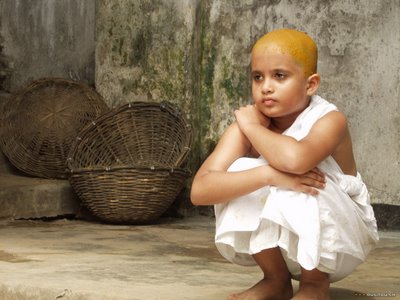
Yesterday was the 61st anniversary of the atomic bombing of Hiroshima and, three days later, Nagasaki.
On August 6, 1945, a United States Air Force B-29 aircraft, called the "Enola Gay", dropped the "Little Boy" atomic bomb on Hiroshima, Japan.
It was the first atomic bomb ever used in war. It ended up killing between 130,000 to 150,000 people.
The bomb leveled Hiroshima to the ground. It exploded with the force of 12,000 tons of TNT. The heat from the explosion exceeded 50 million degrees Fahrenheit at the center of the fireball.
The US decision to drop Atomic Bomb is still debated upon. Check out this interesting article
'The Hiroshima Myth'.
Below is an article excerpt from the Net.
The Peace Museum in Hiroshima presents its anti-nuclear message with all the subtlety of a sledge-hammer. Any attempt at describing the visual and mental experience of walking through it would fall well short . There are scale models of the city as it stood at 8 AM on August 6, 1945 and what remained when the last fire burned itself out. There are pictures and video of the damage both to the buildings and inhabitants of Hiroshima.
What follows are some examples of the descriptive text accompanying the exhibits. Re-reading them now, I am struck by the reduced impact of these statements when taken out of the context of the museum.
Japan's military situation in the Pacific War worsened in 1945. Imperial headquarters foresaw that the Japanese mainland would become a battlefield and called for "100 million deaths with honour."
President Truman's national address on August 7, 1945:
"The basic power of the universe has been harnessed for war by the United States. The force from which the sun draws its powers has been loosed against those who brought war to the Far East."
Three factors probably lead to the hasty deployment of the atomic bomb just days after the first successful test:
In forcing Japanese capitulation the US averted the high cost of lives likely to accompany a conventional assault of Japan At Yalta in 1945, Stalin promised a Soviet presence in the Pacific war. The US secured its political presence by forcing Japan's surrender before Soviet involvement.
Measure the effectiveness of the bomb as a weapon.
By August 1945 most Japanese cities had been destroyed by air raids. Hiroshima was unusually spared. It's choice as the primary target of attacks was probably determined by:
- The size and shape of the city was suited to A-bomb power and since there was no existing damage, assessing effectiveness of the bomb would be relatively easy.
- Despite being previously spared as an air-raid target, Hiroshima was an important city with high concentrations of troops, military hardware, industry and it was a transportation hub.
On August 10 the Japanese government formally protested the new bomb, claiming it to be a cruel, inhuman weapon that violated international law.
Those who survived called the A-bomb 'pika don'. 'Pika' referred to the flash of light. 'Don' was an onomatopoeic reference to the tremendous sound.
On a charred wall at Fukuromachi Elementary school, about 500 meters from the hypocentre, people scrawled news and messages in chalk. In addition, small message boards were setup at the ruins of burnt houses telling of family members who had died or where survivors were taking refuge.
On or about August 8, a Japanese study team discovered that film in a hospital x-ray room had been exposed. From this evidence, the Japanese government deduced that the new bomb was atomic.
During September and October of the year, another team of Japanese scientists surveyed residual radiation. The documentary film they produced during their study was confiscated by the occupation forces and taken to the US. It was finally returned to Hiroshima in 1973.
In October 1945, US soldiers and scientists surveyed and measured what was called the A-bomb effect. The complete results of that study have yet to be made public.
The atomic bomb that exploded 580 meters above Hiroshima was powered by splitting 855 grams of uranium. The energy released was equivalent to 15,000 tons of TNT.
The splitting of uranium nuclei generated both initial radiation (gamma rays and neutrons) and residual radiation. The neutron radiation lasted a brief instant. The initial gamma rays remained at dangerous levels for approximately 20 seconds. Residual radiation consisted of gamma and beta rays emitted over an extended period.
The bomb created a high-temperature, high-pressure fireball which grew to a diameter of approximately 410 meters one second after detonation. The fireball emitted intense thermal rays for up to three seconds and continued to glow for approximately ten seconds. The shock wave at the leading edge of the blast traveled eleven kilometers in 30 seconds.
The super-hot fireball (several million degrees in the center) emitted thermal rays primarily as ultraviolet and visible light radiation. The temperature on the ground near the hypocenter reached 3,000 to 11,000 degrees Celsius.
The fireball created a super-sonic shockwave and pressures of several hundred thousand atmospheres. On the ground near the hypocenter this pressure reached 35 tons per square meter. The intial shockwave was followed by winds blowing 440 meters per second.
The following is a verse from "Flower of Summer" (Natsu no Hana), a collection of short stories by Tamik Hara (1905-1951), writer and A-bomb survivor.
This is a human being?
Look how the atom bomb changed it.
Flesh swells fearfully.
All men and women take one shape.
The voice that trickles from swollen lips
On the festering charred-black face
Whispers the thin words,
"Please, help me."
This, this is a human being.
This is the face of a human being.
There were two types of residual radiation. Induced radiation resulted from the interaction of initial radiation neutrons with the materials in the ground and buildings. Fallout ("Ashes of Death") derived from fission fragments produced when the uranium atoms were split. Levels of induced radiation remained high for approximately 100 hours within 11 kilometers of the hypocenter. Radiation from fallout and fission fragments was weaker but lasted longer. Furthermore, large amounts of radioactive material fell in the "Black Rain."
The damage done to human bodies by radiation has been referred to generally as A-bomb disease, or radiation sickness.
Acute damage refers to symptoms that appear within four months. In addition to complications associated with burns and external injuries, common symptoms of radiation sickness include hair loss, bleeding, lowered levels of white blood cells.
The symptoms known as after-effects began with keloids, which appeared the year after the bombing. Later, radiation produced high rates of cataracts, leukemia and various cancers. It also produced high rates of birth defects among those exposed in-utero.
Some victims who entered the city after the bombing became sick or died from what is believed to be exposure to residual radiation.
In and around what was known as the genbaku sebaku (A-bomb desert) the city struggled to gather enough manpower to dispose of the corpses, but many remained in view nearly two weeks after the bombing.
Some symptoms of A-bomb disease imitate dysentary. Thus, many health care providers were surprised by what seemed to be an epidemic of dysentery spreading throughout the city and surrounding areas. Only later was the cause found to be radiation.
After the bombing violent fires raged throughout the city, and a giant windstorm broke out. Heavy rain fell over the north-west of Hiroshima. For the first hour or two the rain fell black, discoloured by mud, dust blown up at the time of the explosion. The soot too was strongly radioactive. It killed many fish in the rivers and ponds and people who drank well water suffered from terrible diarrhea for up to three months aftwerward.
After the A-bomb sickness had passed, healed scar tissue became thick and contracted, toughening and wrinkling the skin to form growths known as keloids. This symptom was most common during 1946-1947. Keloids developed on fifty to sixty percent of those who suffered first-degree burns within about 2 kilometers of the hypocenter. Being grotesque, painful and itchy they caused people both physical and mental suffering.
Huge numbers of people unable to endure their injuries or burns, jumped into the river that runs in front of the A-bomb dome. Thousands of corpses were seen floating in all Hiroshimas rivers. The once majestic dome of the Hiroshima Prefectural Industrial Promotion Hall will be preserved in perpetuity on the bank of the Motoyatsu River as a mute reminder of the tragedy and concrete appeal for world peace.
Several days after the A-bombing, many children could be seen wandering alone, or in groups, through the burnt ruins of the city. Thousands had been evacuated prior to the bombing and returned later to find that their guardians had perished. THese "A-bomb orphans" were housed in camps, but many died from the effects of radiation or acute malnutrition.
At noon on August 15, 1945, those who had survived the war heard the Emperor's voice on the radio. "...the enemy used a cruel new bomb..." The voice, distorted by static, faded in and out, but the message was clear. Japan had surrendered unconditionally to Allied forces.
The people of Hiroshima greeted the news with mixed emotions. Bitter at the defeat, dazed by disaster, and mourning the relatives they had lost to the atomic bomb, they were also relieved that the threat of further bombing was gone. They had been assured for years of Japan's certain victory. Now they were facing a turbulent, uncertain future.
Hibakusha [survivors of the A-bombs] say simply, "I met with the A-bomb." Perhaps they use this expressioni because the event they "met with" defies description, an instant of massive destruction, mind-numbing death and injuries and grief of watching helplessly as family members, relatives, friends and neigbours died in agony. They also say, "It's painful even to remember." The A-bomb witnesses have overcome that pain and are passing on their experiences of that day. They feel duty bound to tell the world why nuclear weapons must never be used again.
Sadako Sasaki, exposed to the A-bomb in Hiroshima at the age of two contracted leukemia a decade later, and in 1955 died at the age of 12. Believing that folding 1,000 paper cranes would cure her disease, Sadako folded one after another in her hospital bed. After her death, her classmates at the Nabori-machi elementary school conducted prayer meetings to console the souls of many children who were killed by the A-bomb. They also initiated a movement that lead to the Children's Peace Monument.
Sadako's story has spread throughout the world and through it, folded paper cranes have become a symbol of peace. At the foot of the Children's Peace Monument lies a continuously replenished pile of folded cranes sent from all over the world.
Successive mayors of Hiroshima have sent telegrams protesting every nuclear weapons test since 1968. The telegrams are sent to the countries responsible for the tests, and each expresses the fervent hope that it will be the last such telegram.












